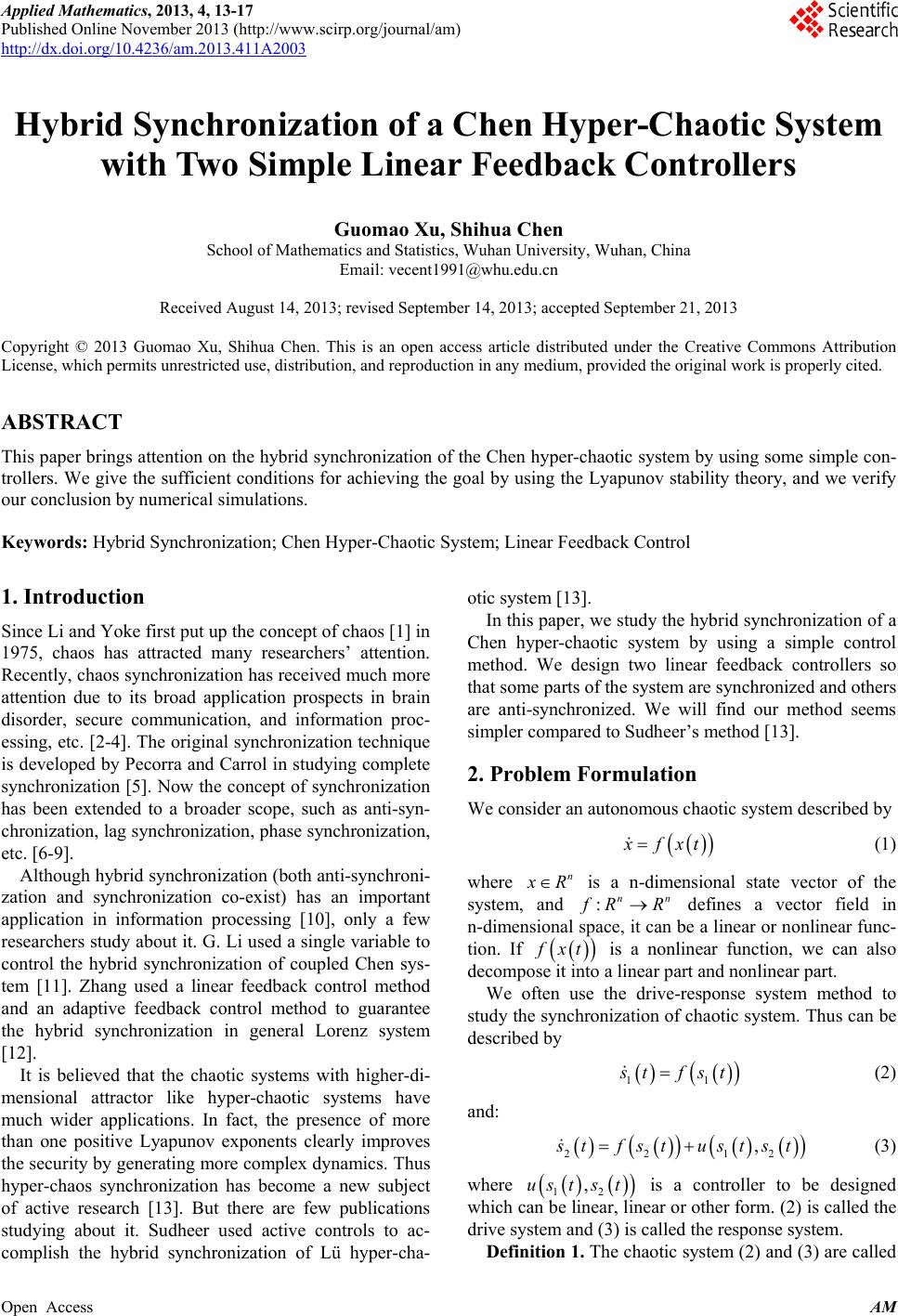 Applied Mathematics, 2013, 4, 13-17 Published Online November 2013 (http://www.scirp.org/journal/am) http://dx.doi.org/10.4236/am.2013.411A2003 Open Access AM Hybrid Synchronization of a Chen Hyper-Chaotic System with Two Simple Linear Feedback Controllers Guomao Xu, Shihua Chen School of Mathematics and Statistics, Wuhan University, Wuhan, China Email: vecent1991@whu.edu.cn Received August 14, 2013; revised September 14, 2013; accepted September 21, 2013 Copyright © 2013 Guomao Xu, Shihua Chen. This is an open access article distributed under the Creative Commons Attribution License, which permits unrestricted use, distribution, and reproduction in any medium, provided the original work is properly cited. ABSTRACT This paper brings attention on the hybrid synchronization of the Chen hyper-chaotic system by using some simple con- trollers. We give the sufficient conditio ns for achieving the goal by using the Lyapu nov stability theory, and we verify our conclusion by numerical simulations. Keywords: Hybrid Synchronization; Chen Hyper-Chaotic System; Linear Feedback Control 1. Introduction Since Li and Yoke first put up the concept of chaos [1] in 1975, chaos has attracted many researchers’ attention. Recently, chaos synchronization has received much more attention due to its broad application prospects in brain disorder, secure communication, and information proc- essing, etc. [2-4]. The original synchronization technique is developed by Pecorra and Carrol in studying complete synchronization [5]. Now the concept of synchronization has been extended to a broader scope, such as anti-syn- chronization, lag synchronization, phase synchronization, etc. [6-9]. Although hybrid synchronization (both anti-synchroni- zation and synchronization co-exist) has an important application in information processing [10], only a few researchers study about it. G. Li used a single variable to control the hybrid synchronization of coupled Chen sys- tem [11]. Zhang used a linear feedback control method and an adaptive feedback control method to guarantee the hybrid synchronization in general Lorenz system [12]. It is believed that the chaotic systems with higher-di- mensional attractor like hyper-chaotic systems have much wider applications. In fact, the presence of more than one positive Lyapunov exponents clearly improves the security by generating more complex dynamics. Thus hyper-chaos synchronization has become a new subject of active research [13]. But there are few publications studying about it. Sudheer used active controls to ac- complish the hybrid synchronization of Lü hyper-cha- otic system [13]. In this paper, we study the hybrid synchronization of a Chen hyper-chaotic system by using a simple control method. We design two linear feedback controllers so that some parts of the system are synchronized and others are anti-synchronized. We will find our method seems simpler compared to Sudheer’s method [13]. 2. Problem Formulation We consider an autonomous chaotic system described by fxt (1) where n R is a n-dimensional state vector of the system, and :nn RR defines a vector field in n-dimensional space, it can be a linear or nonlinear func- tion. If xt is a nonlinear function, we can also decompose it into a linear part and nonlinear part. We often use the drive-response system method to study the synchronization of chaotic system. Thus can be described by 11 tfst (2) and: 2212 , tfstustst (3) where 12 ,us tst is a controller to be designed which can be linear, linear or other form. (2) is called the drive system and (3) is called the response system. Definition 1. The chaotic syste m (2) and (3) a re called 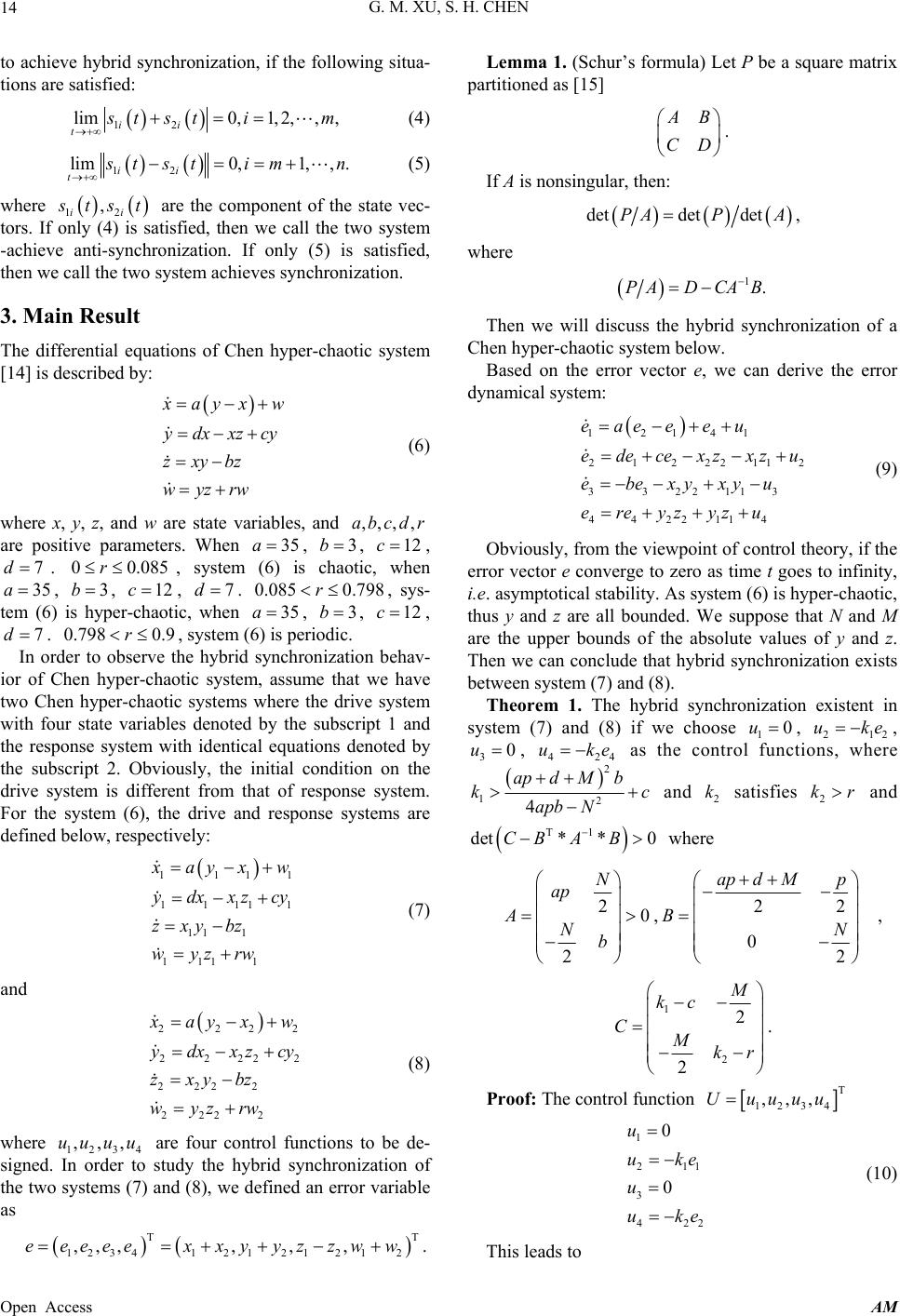 G. M. XU, S. H. CHEN 14 to achieve hybrid synchronization, if the following situa- tions are satisfied: 12 lim0,1,2,, , ii t tst im (4) 12 lim0,1,, . ii t tst imn (5) where 12ii , ts t are the component of the state vec- tors. If only (4) is satisfied, then we call the two system -achieve anti-synchronization. If only (5) is satisfied, then we call the two system achieves synchronization. 3. Main Result The differential equations of Chen hyper-chaotic system [14] is described by : ay xw ydxxzcy zxybz wyzrw (6) where x, y, z, and w are state variables, and are positive parameters. When , , ,,,,abc dr 312c35ab , . , system (6) is chaotic, when , , , . , sys- tem (6) is hyper-chaotic, when , , 7d35a0 0.085r 3b12c7d0.085 35a0.798 312c r b , . , system (6) is periodic. 7d0.7980.9r In order to observe the hybrid synchronization behav- ior of Chen hyper-chaotic system, assume that we have two Chen hyper-chaotic systems where the drive system with four state variables denoted by the subscript 1 and the response system with identical equations denoted by the subscript 2. Obviously, the initial condition on the drive system is different from that of response system. For the system (6), the drive and response systems are defined below, respectively: 111 1111 11 1 111 1 1 1 ay xw ydxxzcy zxy bz wyzrw (7) and 222 2222 222 2 222 2 2 2 ay xw ydxxzcy zxybz wyzrw (8) where 1234 are four control functions to be de- signed. In order to study the hybrid synchronization of the two systems (7) and (8 ), we defined an error variab le as ,,,uuuu TT 1234121212 12 ,,,,, ,eeeeexxyyzzww Lemma 1. (Schur’s formula) Let P be a square matrix partitioned as [15] B CD . If A is nonsingular, then: detdet detPAP A, where 1.PADCA B Then we will discuss the hybrid synchronization of a Chen hyper-chaotic system below. Based on the error vector e, we can derive the error dynamical system: 12141 2122211 3322113 4422114 eaeeeu edecexzxzu ebexyxyu ereyzyzu 2 (9) Obviously, from the v iewpoint of control theory, if the error vector e converge to zero as time t goes to infinity, i.e. asymptotical stability. As system (6) is hyper-chaotic, thus y and z are all bounded. We suppose that N and M are the upper bounds of the absolute values of y and z. Then we can conclude that hybrid synchronization exists between system (7) and (8). Theorem 1. The hybrid synchronization existent in system (7) and (8) if we choose 1, 212 0uuke , 30u , 42 uk 4 e as the control functions, where 2 12 4 ap dMb k apb N c 2 k and satisfies and 2 kr T1 det* *0CB AB where 20 2 N ap ANb ,22 02 ap dMp BN , 1 2 2 2 kc CMkr . Proof: The control function T 1234 ,,,Uuuuu 1 21 3 42 0 0 u uke u uk 1 2 e (10) . This leads to Open Access AM 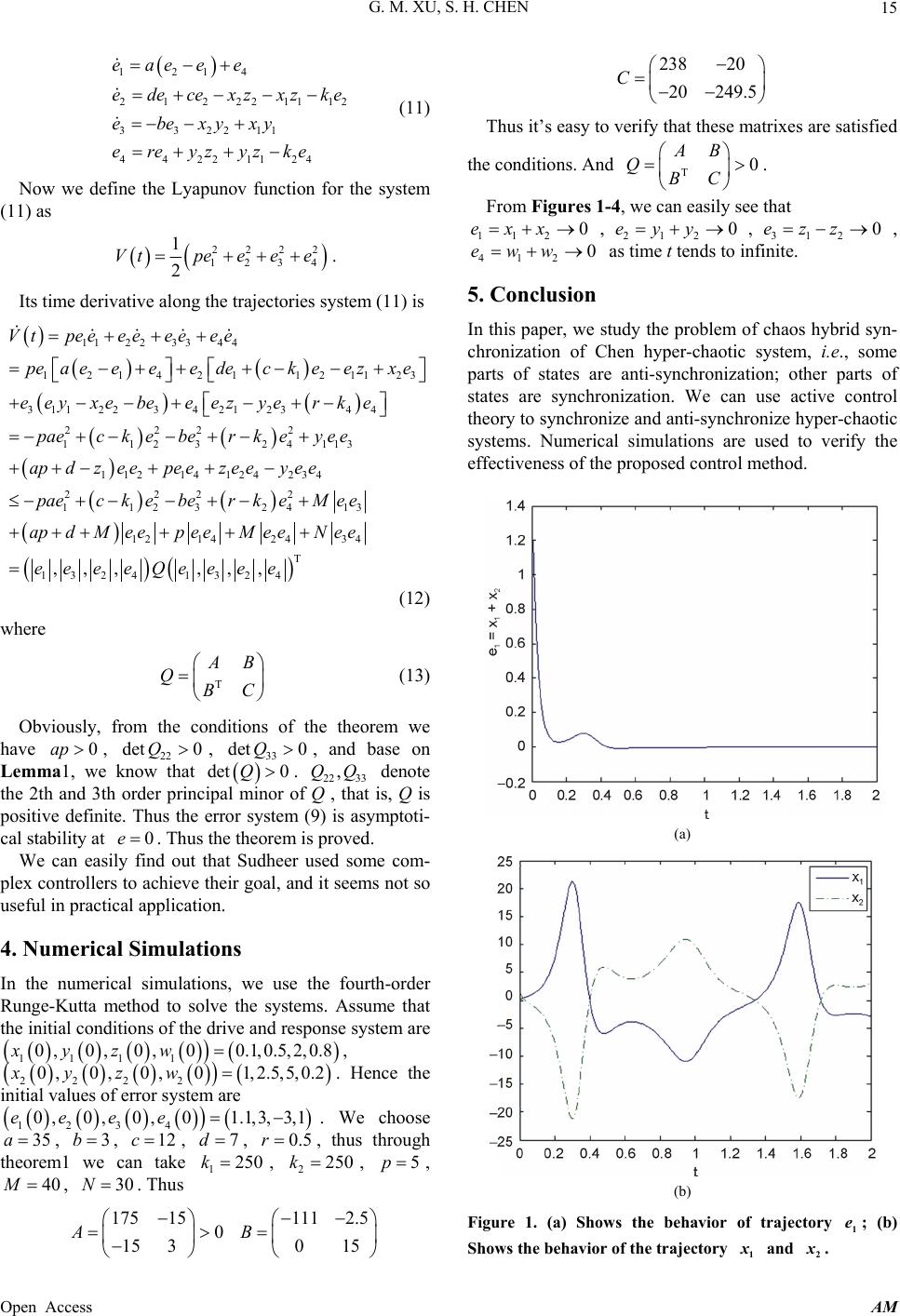 G. M. XU, S. H. CHEN 15 1214 21222111 332211 44221124 eaeee edecexzxzke ebexyxy ereyzyzke 2 (11) Now we define the Lyapunov function for the system (11) as 2222 1234 1 2 Vt peeee. Its time derivative along the trajectories system (11) is 1122 3344 121421 121123 3112234 212344 222 2 112324113 11214 124234 222 1123 Vtpee eeeeee peae eeedecke ez xe eeyxebe eezye rke paeckeberkeyee apdze epe ez eeyee paeck eber 2 24 13 12 142434 T 1324 1324 ,,, ,,, ke Mee apdMe epe eMeeNe e eeeeQeeee (12) where T B QBC (13) Obviously, from the conditions of the theorem we have , 22 , , and base on Lemma1, we know that 0ap det 0Q33 det 0Q 0Qdet . 2233 denote the 2th and 3th order principal minor of Q , that is, Q is positive definite. Thus the error system (9) is asymptoti- cal stability at . Thus the theorem is proved. ,QQ 0e We can easily find out that Sudheer used some com- plex controllers to achieve their goal, and it seems not so useful in practical application. 4. Numerical Simulations In the numerical simulations, we use the fourth-order Runge-Kutta method to solve the systems. Assume that the initial conditions of the drive and response system are 1111 0 ,0 ,0 ,00.1,0.5,2,0.8xyzw , 2222 0,0,0,01,2.5,5,0.2xyzw . Hence the initial values of error system are 1234 0, 0,0, 01.1,3,3,1eeee 35a3b12c7d0.5r 1250k . We choose , , , , , thus through theorem1 we can take , , 225k05p , , . Thus 40M30N 17515 0 15 3 A 111 2.5 015 B 238 20 20 249.5 C Thus it’s easy to verify that these matrixes are satisfied the conditions. And T0 AB QBC . From Fi gu r e s 1-4, we can easily see that 1120exx ,2120eyy ,31 , 20ezz 412 0eww as time t tends to infinite. 5. Conclusion In this paper, we study the problem of chaos hybrid syn- chronization of Chen hyper-chaotic system, i.e., some parts of states are anti-synchronization; other parts of states are synchronization. We can use active control theory to synchronize and anti-synchronize hyper-chaotic systems. Numerical simulations are used to verify the effectiveness of the proposed control method. (a) (b) Figure 1. (a) Shows the behavior of trajectory ; (b) Shows the behavior of the trajectory and . e1 x1x2 Open Access AM 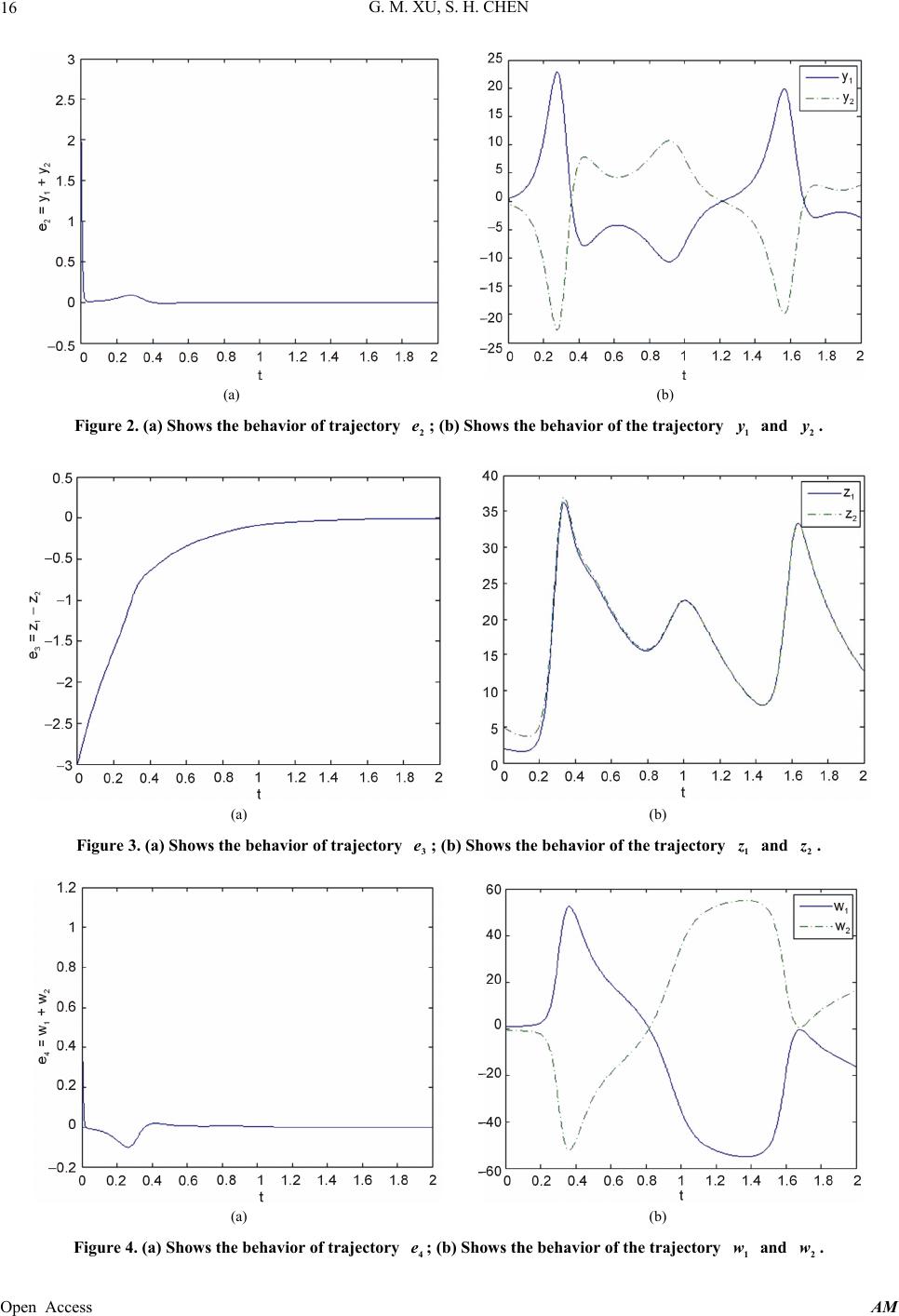 G. M. XU, S. H. CHEN Open Access AM 16 (a) (b) Figure 2. (a) Shows the behavior of trajectory ; (b) Shows the behavior of the trajectory e2 1 and 2. (a) (b) Figure 3. (a) Shows the behavior of trajectory ; (b) Shows the behavior of the trajectory and . e3z1z2 (a) (b) Figure 4. (a) Shows the behavior of trajectory ; (b) Shows the behavior of the trajectory and . 4 e1 w2 w 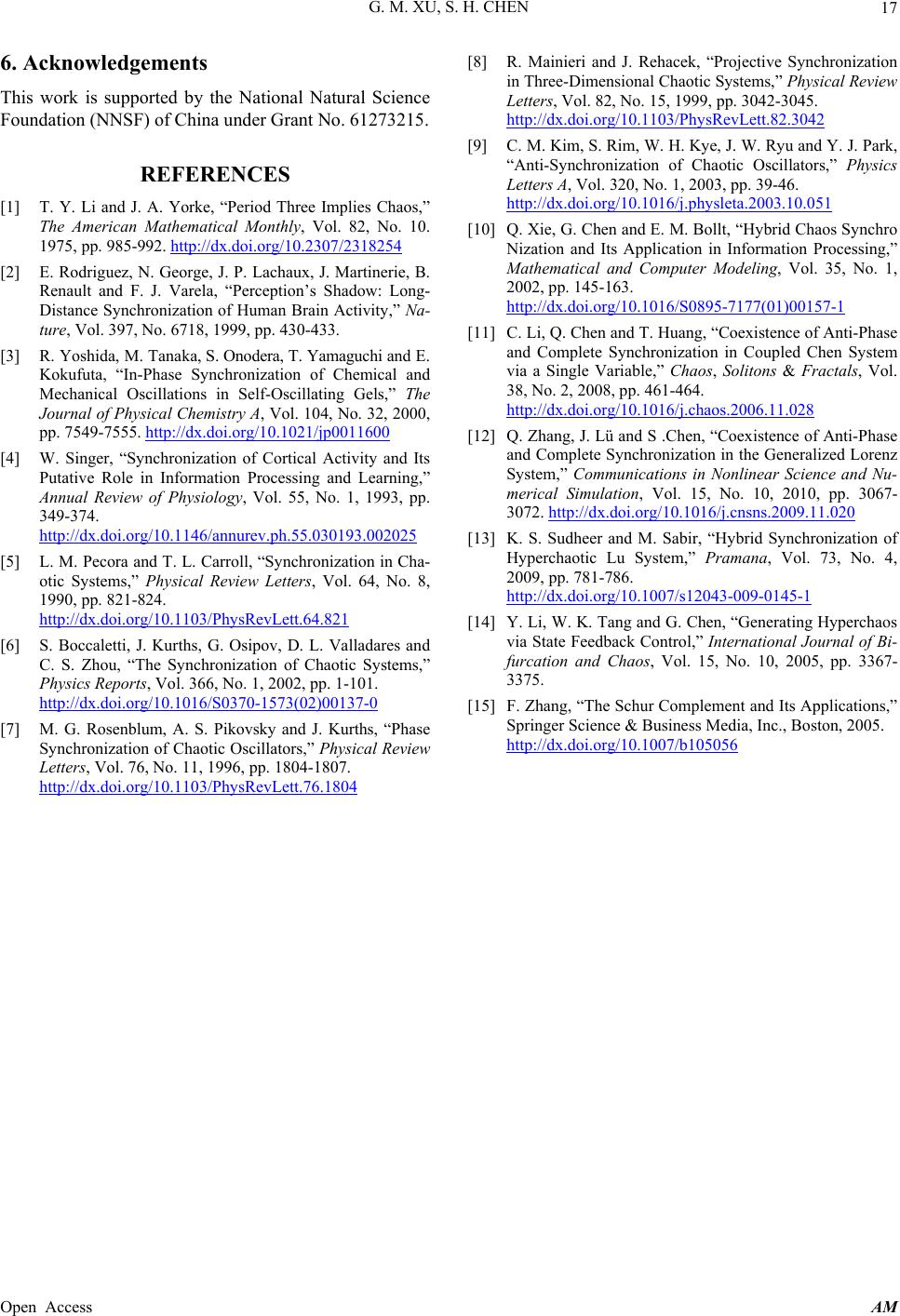 G. M. XU, S. H. CHEN 17 6. Acknowledgements e National Natural Scien under Grant No. 6 127 [1] T. Y. Li and Je Implies Cha The American, Vol. 82, No. 10. [8] R. Mainieri and J. Rehacek, “Projective Synchronization in Three-Dimensional Chaotic Systems,” Physical Review This work is supported by th Foundation (N NSF) of Chinace 3215. REFERENCES . A. Yorke, “Period Thre Mathematical Monthlyos,” 1975, pp. 985-992. http://dx.doi.org/10.2307/2318254 [2] E. Rodriguez, N. George, J. P. Lachaux, J. Martinerie, B. Renault and F. J. Varela, “Perception’s Shadow: Long- Distance Synchronization of Human Brain Activity,” Na- ture, Vol. 397, No. 6718, 1999, pp. 430-433. [3] R. Y os hi da , M. T an a ka, S. Onod era, T. Yamaguchi an d E. Kokufuta, “In-Phase Synchronization of Chemical and Mechanical Oscillations in Self-Oscillating Gels,” The Journal of Physical Chemistry A, Vol. 104, No. 32, 2000, pp. 7549-7555. http://dx.doi.org/10.1021/jp0011600 [4] W. Singer, “Synchronization of Cortical Activity and Its Putative Role in Information Processing and Learning,” Annual Review of Physiology, Vol. 55, No. 1, 1993, pp. 349-374. http://dx.doi.org/10.1146/annurev.ph.55.030193.002025 [5] L. M. Pec otic Systems,” Physical Review Letters, Vol. 64, No. 8 ora and T. L. Carroll, “Synchronization in Cha- , 1990, pp. 821-824. http://dx.doi.org/10.1103/PhysRevLett.64.821 [6] S. Boccaletti, J. Kur C. S. Zhou, “The Synchronization of Chaotic ths, G. Osipov, D. L. Valladares and Systems,” Physics Reports, Vol. 366, No. 1, 2002, pp. 1-101. http://dx.doi.org/10.1016/S0370-1573(02)00137-0 [7] M. G. Rosenblum, A. S. Pikovsky and J. Kurths, “P Synchronization of Chaotic Oscillators,” Physical Rev hase iew Letters, Vol. 76, No. 11, 1996, pp. 1804-1807. http://dx.doi.org/10.1103/PhysRevLett.76.1804 Letters, Vol. 82, No. 15, 1999, pp. 3042-3045. http://dx.doi.org/10.1103/PhysRevLett.82.3042 [9] C. M. Kim, S. Rim, W. H. Kye, J. W. Ryu and Y “Anti-Synchronization of Chaotic Oscillators,”. J. Park, Physics Letters A, Vol. 320, No. 1, 2003, pp. 39-46. http://dx.doi.org/10.1016/j.physleta.2003.10.051 [10] Q. Xie, G. Chen and E. M. Bollt, “Hybrid Ch Nization and Its Application in Information Processing,” aos Synchro Mathematical and Computer Modeling, Vol. 35, No. 1, 2002, pp. 145-163. http://dx.doi.org/10.1016/S0895-7177(01)00157-1 [11] C. Li, Q. Chen and T and Complete Synchronization in Coupled Chen S . Huang, “Coexistence of Anti-Phase ystem via a Single Variable,” Chaos, Solitons & Fractals, Vol. 38, No. 2, 2008, pp. 461-464. http://dx.doi.org/10.1016/j.chaos.2006.11.028 [12] Q. Zhang, J. Lü and S .Chen, “ and Complete Synchronization in the Generali Coexistence of Anti-Phase zed Lorenz System,” Communications in Nonlinear Science and Nu- merical Simulation, Vol. 15, No. 10, 2010, pp. 3067- 3072. http://dx.doi.org/10.1016/j.cnsns.2009.11.020 [13] K. S. Sudheer and M. Sabir, “Hybrid Synchronization of Hyperchaotic Lu System,” Pramana, Vol. 73, No. 4, 2009, pp. 781-786. http://dx.doi.org/10.1007/s12043-009-0145-1 [14] Y. Li, W. K. Tang a via State Feedback Control,” International Jou nd G. Chen, “Generating Hyperchaos rnal of Bi- r Science & Business Media, Inc., Boston, 2005. furcation and Chaos, Vol. 15, No. 10, 2005, pp. 3367- 3375. [15] F. Zhang, “The Schur Complement and Its Applications,” Springe http://dx.doi.org/10.1007/b105056 Open Access AM
|